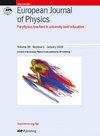How understanding large language models can inform the use of ChatGPT in physics education
IF 0.8
4区 教育学
Q4 EDUCATION, SCIENTIFIC DISCIPLINES
引用次数: 0
Abstract
The paper aims to fulfil three main functions: (1) to serve as an introduction for the physics education community to the functioning of Large Language Models (LLMs), (2) to present a series of illustrative examples demonstrating how prompt-engineering techniques can impact LLMs performance on conceptual physics tasks and (3) to discuss potential implications of the understanding of LLMs and prompt engineering for physics teaching and learning. We first summarise existing research on the performance of a popular LLM-based chatbot (ChatGPT) on physics tasks. We then give a basic account of how LLMs work, illustrate essential features of their functioning, and discuss their strengths and limitations. Equipped with this knowledge, we discuss some challenges with generating useful output with ChatGPT-4 in the context of introductory physics, paying special attention to conceptual questions and problems. We then provide a condensed overview of relevant literature on prompt engineering and demonstrate through illustrative examples how selected prompt-engineering techniques can be employed to improve ChatGPT-4’s output on conceptual introductory physics problems. Qualitatively studying these examples provides additional insights into ChatGPT’s functioning and its utility in physics problem solving. Finally, we consider how insights from the paper can inform the use of LMMs in the teaching and learning of physics.了解大型语言模型如何为在物理教育中使用 ChatGPT 提供依据
本文旨在实现三个主要功能:(1)向物理教育界介绍大型语言模型(LLM)的功能;(2)提供一系列示例,说明提示工程技术如何影响 LLM 在概念物理任务中的表现;(3)讨论对 LLM 和提示工程的理解对物理教学的潜在影响。我们首先总结了现有的关于基于 LLM 的流行聊天机器人(ChatGPT)在物理任务上的表现的研究。然后,我们介绍了 LLM 的基本工作原理,说明了其功能的基本特征,并讨论了其优势和局限性。有了这些知识,我们将讨论在物理入门中使用 ChatGPT-4 生成有用输出所面临的一些挑战,并特别关注概念性问题和难题。然后,我们简要概述了有关提示工程的相关文献,并通过示例演示了如何使用选定的提示工程技术来改进 ChatGPT-4 在概念性物理入门问题上的输出。通过对这些示例的定性研究,我们对 ChatGPT 的功能及其在物理问题解决中的实用性有了更多的了解。最后,我们将探讨本文的见解如何为在物理教学中使用 LMMs 提供参考。
本文章由计算机程序翻译,如有差异,请以英文原文为准。
求助全文
约1分钟内获得全文
求助全文
来源期刊

European Journal of Physics
物理-物理:综合
CiteScore
1.70
自引率
28.60%
发文量
128
审稿时长
3-8 weeks
期刊介绍:
European Journal of Physics is a journal of the European Physical Society and its primary mission is to assist in maintaining and improving the standard of taught physics in universities and other institutes of higher education.
Authors submitting articles must indicate the usefulness of their material to physics education and make clear the level of readership (undergraduate or graduate) for which the article is intended. Submissions that omit this information or which, in the publisher''s opinion, do not contribute to the above mission will not be considered for publication.
To this end, we welcome articles that provide original insights and aim to enhance learning in one or more areas of physics. They should normally include at least one of the following:
Explanations of how contemporary research can inform the understanding of physics at university level: for example, a survey of a research field at a level accessible to students, explaining how it illustrates some general principles.
Original insights into the derivation of results. These should be of some general interest, consisting of more than corrections to textbooks.
Descriptions of novel laboratory exercises illustrating new techniques of general interest. Those based on relatively inexpensive equipment are especially welcome.
Articles of a scholarly or reflective nature that are aimed to be of interest to, and at a level appropriate for, physics students or recent graduates.
Descriptions of successful and original student projects, experimental, theoretical or computational.
Discussions of the history, philosophy and epistemology of physics, at a level accessible to physics students and teachers.
Reports of new developments in physics curricula and the techniques for teaching physics.
Physics Education Research reports: articles that provide original experimental and/or theoretical research contributions that directly relate to the teaching and learning of university-level physics.
 求助内容:
求助内容: 应助结果提醒方式:
应助结果提醒方式:


